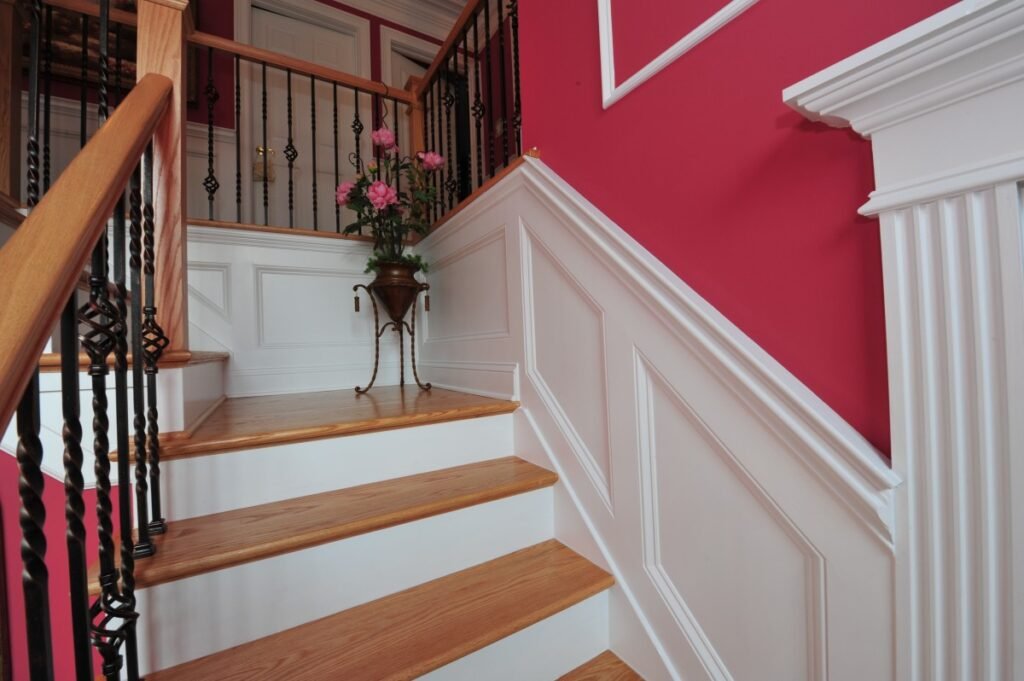When it comes to interior design trends, sometimes the classics are the best. Wainscoting, a feature originally designed for wall protection, has evolved into a versatile design element. From traditional beadboard in a Boston home to sleek panels in a Buffalo loft or a sunlit Orlando rental, wainscoting ideas have expanded beyond their traditional boundaries.
Wainscoting is not just about style; it adds purpose and personality to walls. In this guide, we’ll explore what wainscoting is, its benefits, various styles, installation tips, and design inspiration, all with expert advice.
What is wainscoting? How it adds style and function
Wainscoting involves applying wooden or composite panels to a portion of an interior wall. Originally used for protection, it now adds texture, balance, and visual interest to a space.
According to Richmond-based John Durham, wainscoting is a panel application using different trim moldings to add character to rooms like hallways and dining rooms.
Wainscoting is a foundational architectural detail that brings balance to blank walls, according to Robert Mann in Tucson, AZ.
Why is it called wainscoting?
The term originates from Middle Dutch, referring to high-quality oak boards used to line wagon interiors or protect lower wall surfaces in homes. Over time, it evolved into decorative wall paneling for protection and aesthetics.
Wainscoting began as a practical way to shield walls from wear and tear and has now become a signature design feature.
Expert contributors:

Photo courtesy of Pasko’s Artistic Carpentry
What is the purpose of wainscoting?
Wainscoting serves various purposes beyond visual appeal:
1. Protecting high-traffic areas
Wainscoting protects walls from damage and adds structural durability to interior spaces, making it ideal for high-traffic areas like mudrooms and hallways.
2. Hiding imperfections and insulating
It can cover plaster or drywall damage and provide insulation and soundproofing benefits, especially in older homes.
3. Functional versatility
Wainscoting protects walls, provides insulation, and adds aesthetic appeal, making it suitable for various spaces like kitchens and bathrooms.
Expert contributors:

Photo courtesy of John Durham Carpentry
Can you use wainscoting in any room?
Wainscoting is incredibly versatile and can be added to almost any room. Entryways, hallways, dining rooms, bathrooms, living rooms, bedrooms, kitchens, mudrooms, and laundry rooms can all benefit from wainscoting, enhancing both charm and protection.
The different types of wainscoting
There are various types of wainscoting to choose from, each suitable for different interior styles:
- Raised Panel: Beveled edges with a three-dimensional look, common in colonial or formal homes.
- Flat Panel (Shaker): Clean and simple with recessed panels, ideal for contemporary designs.
- Beadboard: Narrow vertical planks separated by grooves, popular in bathrooms and casual spaces.
- Board and Batten: Vertical strips creating a rustic, farmhouse-inspired appearance.
- Overlay: Flat panels with decorative moldings for added depth.
- Shiplap: Horizontally placed boards with small gaps, trendy in modern farmhouses and coastal interiors.
- Tongue and Groove: Interlocking planks for a seamless look, offering durability and coverage.
Each style adds visual interest, shadow, and texture to break up large wall expanses.
Expert contributors:
- Trim Team, a woodworking company in Toronto, ON
- Lori Nicholson from Style Revamp, a design firm specializing in finished carpentry

Wainscoting vs. other wall treatments
Wainscoting adds physical structure and proportion to a wall, unlike paint or wallpaper which primarily alter color or pattern. It gives rooms a sense of craftsmanship and permanence.
It is particularly valuable in large or awkward rooms, breaking up the wall visually and providing rhythm and balance, according to Matt Stanczak.
Expert contributors:
- Mike Van, co-founder of home furnishing service, Furnishr
- Matt Stanczak from Wainscoting Arizona, crown molding and baseboard specialists.
Tips for planning and installation
Choosing the right materials and proper preparation are essential for a successful wainscoting installation. Material selection and installation techniques impact the look and longevity of wainscoting.
Material and installation tips:
- Use moisture-resistant materials like MDF or PVC in bathrooms and kitchens to prevent warping.
- Opt for hardwoods like oak or walnut in living areas for a warm finish.
- Consider reclaimed wood or textured composites for sustainability and cost-effectiveness.
- Map out paneling with painter’s tape and a laser level, especially in homes with uneven walls.
- Check for outlets or switches before installing panels to avoid mid-project surprises.
- Start layout from the center of the wall for symmetry and balance.
- Maintain consistent panel sizes for a professional look.
Almost any durable surface can be used for wainscoting, from wood to stone to textured composites, according to Erik Nelson.
Expert contributors:
Is wainscoting expensive?
Wainscoting can make a significant visual impact without a hefty price tag. The total cost typically ranges from $1,050 to $1,600 depending on room size, style, and installation. Budget-friendly materials like plywood or MDF can cost as little as $1 per square foot, while solid wood may go up to $40. DIY installation can save on labor costs, which typically add $2 to $4 per square foot.


